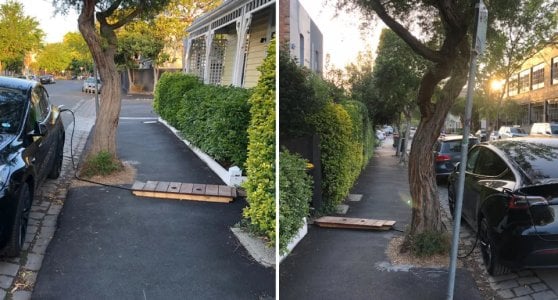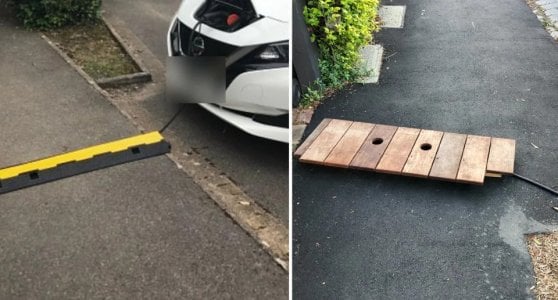Tesla driver's ‘failed’ cable cover-up sparks outrage online
With the rising popularity of electric vehicles (EV) across the country, urban EV owners encounter a shared challenge: How do you charge your car when you lack a driveway or garage?
This issue came to the forefront when a Tesla driver tried to hide their electric car’s charging cable over a footpath, sparking frustration among online users.
In the middle of Melbourne's inner city, a cable stretched from a house to a car parked on the street. On top of this makeshift setup is a wooden support, a clear blockage that caused an uproar online.
‘This is ridiculous. Why are electric car owners blocking the footpath to charge their private cars? This is silly,’ wrote a passerby online, sharing their frustration.
Pictures from the passerby clearly showed the charger and wooden support blocking the walking space.
Some are worried about how people with strollers or wheelchairs would get around this unexpected problem.
‘It’s a worse trip hazard than just the cable,’ said one person.
Another proposed an easy fix, suggesting a ‘cable cover from Bunnings’ could have hidden the charger well without creating a blockage to others.
In addition to the comment, they posted a picture of neatly arranged EV chargers using the suggested solution.
For city residents reliant on EVs, the absence of private off-street parking worsens the issue, forcing them to resort to obstructing footpaths.
The City of Melbourne directs those without private parking to use ‘public charging points’, and communal chargers provided by local councils for all EV owners.
As the city considers placing public on-street chargers in residential areas, EV owners pointed out some logistical challenges—advocating for the simpler solution of home charging.
In some council areas, such as Port Philip south of Melbourne CBD, fines of up to $960 loom for obstructing footpaths with charging cables.
‘Charging an electric vehicle (EV) with a power cord running across a footpath, road or nature strip breaches our local laws and poses a risk to public safety, including for those who are visually impaired,’ Port Phillip Council Mayor Heather Cunsolo told Drive.com.au.
The EV market is also booming as cities transition to more sustainable transport options.
With this, many car owners insist on better charging solutions if governments are to genuinely encourage the widespread adoption of EVs.
‘This is a bad outcome, but let's not blame them for the occasional emergency charge,’ one person noted online, defending the EV owner charger across the footpath.
‘The failure is broader and more complex than this.’

Members, what's your take on this story? Any quick fixes you can suggest for this EV charging issue? Share your thoughts in the comments below!
This issue came to the forefront when a Tesla driver tried to hide their electric car’s charging cable over a footpath, sparking frustration among online users.
In the middle of Melbourne's inner city, a cable stretched from a house to a car parked on the street. On top of this makeshift setup is a wooden support, a clear blockage that caused an uproar online.
‘This is ridiculous. Why are electric car owners blocking the footpath to charge their private cars? This is silly,’ wrote a passerby online, sharing their frustration.
Pictures from the passerby clearly showed the charger and wooden support blocking the walking space.
Some are worried about how people with strollers or wheelchairs would get around this unexpected problem.
‘It’s a worse trip hazard than just the cable,’ said one person.
Another proposed an easy fix, suggesting a ‘cable cover from Bunnings’ could have hidden the charger well without creating a blockage to others.
In addition to the comment, they posted a picture of neatly arranged EV chargers using the suggested solution.
For city residents reliant on EVs, the absence of private off-street parking worsens the issue, forcing them to resort to obstructing footpaths.
The City of Melbourne directs those without private parking to use ‘public charging points’, and communal chargers provided by local councils for all EV owners.
As the city considers placing public on-street chargers in residential areas, EV owners pointed out some logistical challenges—advocating for the simpler solution of home charging.
In some council areas, such as Port Philip south of Melbourne CBD, fines of up to $960 loom for obstructing footpaths with charging cables.
‘Charging an electric vehicle (EV) with a power cord running across a footpath, road or nature strip breaches our local laws and poses a risk to public safety, including for those who are visually impaired,’ Port Phillip Council Mayor Heather Cunsolo told Drive.com.au.
The EV market is also booming as cities transition to more sustainable transport options.
With this, many car owners insist on better charging solutions if governments are to genuinely encourage the widespread adoption of EVs.
‘This is a bad outcome, but let's not blame them for the occasional emergency charge,’ one person noted online, defending the EV owner charger across the footpath.
‘The failure is broader and more complex than this.’
Key Takeaways
- Urban EV owners grapple with the challenge of charging without driveways, highlighting a growing issue with electric vehicle popularity.
- A Tesla driver's attempt to hide a charging cable sparked frustration online, revealing urban EV charging difficulties.
- The absence of private parking exacerbates the issue, compelling city residents to obstruct footpaths for charging, leading to fines in certain cities.
- Amid a global shift from gas cars, the booming EV market calls for improved charging solutions, stressing the need for government support.









